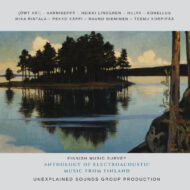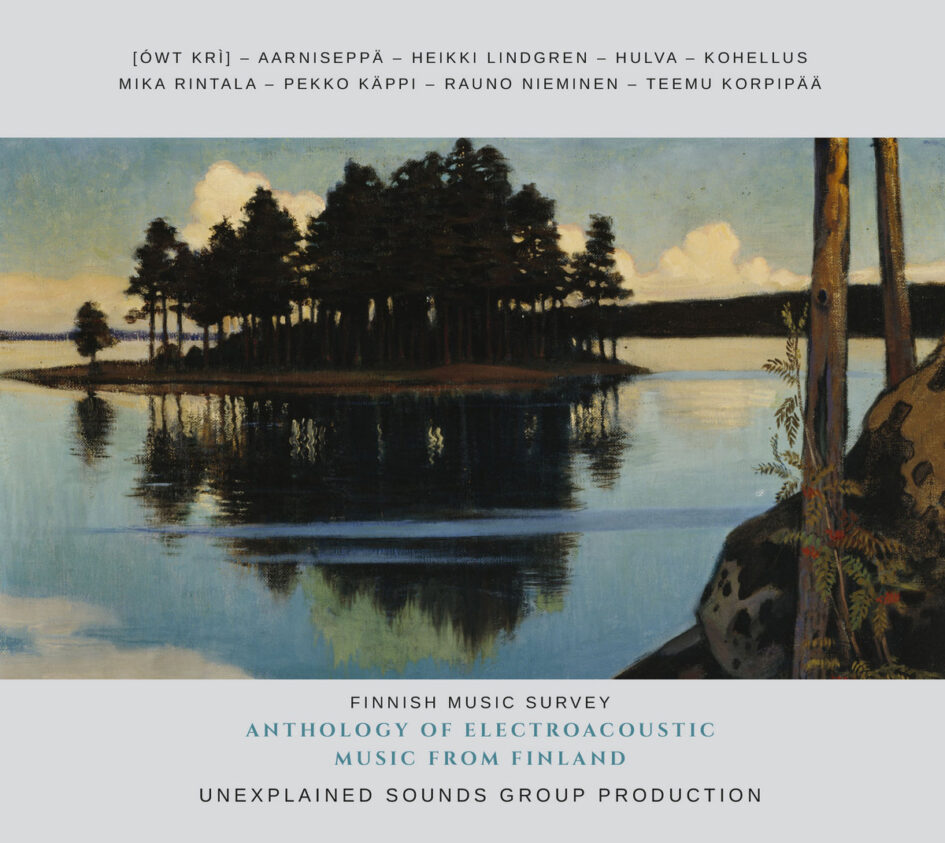 “Finland’s contribution to the world is strange, ambient music. Discuss”. This compilation bears that out. Traditional folk music is the essence, but the Finnish artists develop the concept and take it to another level. This collection is part of a series of anthologies of experimental music from around the world including China, South American and European countries. Here on this compilation are contributions and interpretations from nine Finnish artists. I now know that Finland’s first electronic musical instrument was built at the end of the 19th century. Born from traditional music associated with working in the fields and with communities, advancements in technology, innovation and modernisation through experiment have led to what we have here. It is about concept and impression in a musical context.
“Finland’s contribution to the world is strange, ambient music. Discuss”. This compilation bears that out. Traditional folk music is the essence, but the Finnish artists develop the concept and take it to another level. This collection is part of a series of anthologies of experimental music from around the world including China, South American and European countries. Here on this compilation are contributions and interpretations from nine Finnish artists. I now know that Finland’s first electronic musical instrument was built at the end of the 19th century. Born from traditional music associated with working in the fields and with communities, advancements in technology, innovation and modernisation through experiment have led to what we have here. It is about concept and impression in a musical context.
The common factor, apart from Finland of course, is that the waves of sound which emanate from these pieces enter the senses, fuel the imagination and create disturbance, fear and now and again more pleasant sensations. It was comforting at first to hear Aarniseppâ’s “Dance of Gnomes” with the distant drums, the sounds of animals, birds, the shepherd’s lute and identifiable life. It’s nice to be able to identify things – a natural human reaction in what is ostensibly an alien, potentially hostile world of experimental soundscapes. But then a larger force is present. Electronic waves convey us through the invisible ether. It’s now like being in a machine room. ‘Tis a thing of mystery and sinister beauty. Aarniseppâ also offers us “The Swan Cult”. An unidentified wind instrument brings us the sound of swans. It’s like the shepherd’s lute. The drum beats ominously and the electro-mechanical processing begins. We have gone from the sound of life to the factory, with a piercing drone, sounds of hammering and then the swan-like sounds return. It’s a world of confusion, reinforced as the swans and the electronically derived mechanical processes merge. It’s deeply disturbing and mixes up our brain.
This compilation starts with “Transrational Folk Song n9”. Quiet loops and soft electronic waves put us in a trance and bear the hallmarks of another planet. Folk has found dystopia. From this dark place Kohellus takes us into his world of “Kalanvihreä”. Straightaway I feel cleansed. The wavy drone is friendly, not the dark fog that we often hear, and there is a light and colourful tune from the traditional instrument which sounds a little like a sitar and I’m guessing is the kantele. This meditative piece suggests harmony. A deep wave cuts in to challenge my preconception and a violin-type instrument offers a deep and spiritual perspective on this already rich soundscape. I apologise now for not knowing what all these instruments are, but I can describe the deep sense of richness that they communicate. Although I am being transported to another world, it’s one with which I can now associate. I am not thinking of Finland however. As the flute utters its dreamy statement my mind is turning to the dry and dusty fields of India, where workers are herding oxen and cultivating their crops. As hypnosis goes, this is beautiful. All is at one. There is life in this tranquil music. The capricious flute provides no threat, just delight. The constant beat of the drum and soft drone reinforce the calm and sense of relaxation. Only towards is there a dark disturbance and the suggestion perhaps of rainfall and maybe an oncoming storm but nothing overcomes the profound sense of equilibrium. “Kalanvihreä” is 17 minutes of thought-provoking bliss.
There are two pieces by Heikki Lindgren on this compilation, both collaborations with other artists. I had come across Mr Lindgren before through his essay “Listening to the Baltic Sea” and associated musical piece “Heard from the Shore” on the CChanges project. A description I read about him is that he creates minimal soundscapes which dive into archaic Karelian aesthetics. The first collaboration, called “The Forging of the Kantele” is with Rauno Niemenen, another CChanges contributor with his essay “Musical Instruments and Climate Changes”, which explains the building of instruments and sourcing of the wood. In line with its title, “The Forging of the Kantele” is a fascinating mixture which give the impression of something being developed and constructed albeit in an impressionistic way, while emitting a combination of sounds which cause a sensory explosion. The zither-sounding kantele sits at the epicentre of traditional Finnish instruments. The second piece, with Mika Rintala, is stark and sinister. The deep electronic waves of “Kirkkoherra Penkoi Arkistoja” suggest dark, threatening clouds and dark moods. The sounds themselves are distorted and expansive, radiating and billowing like a trumpet or a deep sea creature. The drone throbs in a threatening manner. “Kirkkoherra Penkoi Arkistoja” comes from a harsh place. This is a different end of the atmospheric spectrum from what we hear elsewhere on this compilation.
“Lokkiranta II” is a contribution from musician and sound engineer Teemu Korpipää. The minimalistic bell-like tones are like the electronic representation of dripping water but with the juxtaposition of high and low notes. The background has the faint crackle, giving the suggestion of running water. Presenting yet another side, Hulva’s “Palsa” is noteworthy for its mystery. With the usual array of sounds, the electronic tune is classical, and follows a pattern but the sound is distorted and from it the ambience is gloomy. Yet midway through the tempo is raised and there’s the suggestion of a distorted polka. And that’s the thing: it’s always suggestion, this allowing our mind to roam and wonder. Waves sweep through as the violin-like piece spreads its experimental winds and finally dissipates into a world of ambient noise. To close we hear “Nyrkes” from [ówt krì]. A hypnotic sound, akin to the knocking on a pipe, stands behind cavernous winds and a distant, sinister, echoing voice. As I have often found with [ówt krì], the musical output seems to be a representation of the goings-on inside someone’s head. This void is filled with expansively dark sounds which on the one hand seem uncontrollable and nightmarish, yet on the other have a rhythm and presence which represent life. Round and round go the loops, like breathing. There has been darkness and there has been light, but now from [ówt krì] are the sounds of intense psychological disturbance passing through like breathing itself. It is testimony to this compilation that there should be such range.
There is much to explore in this field, not least studies on the subject of Finnish electronic sound art by Petri Kuljuntausta, and exhibitions in Helsinki to showcase this fascinating world. But leaving it aside as a research subject, this compilation is an aural exhibition of inventions and soundscapes which are well worth exploring if you like to go beyond conventional musical boundaries and enter different concepts of artistic thinking.
(8/10 Andrew Doherty)
https://unexplainedsoundsgroup.bandcamp.com/album/anthology-of-electroacoustic-music-from-finland

Leave a Reply